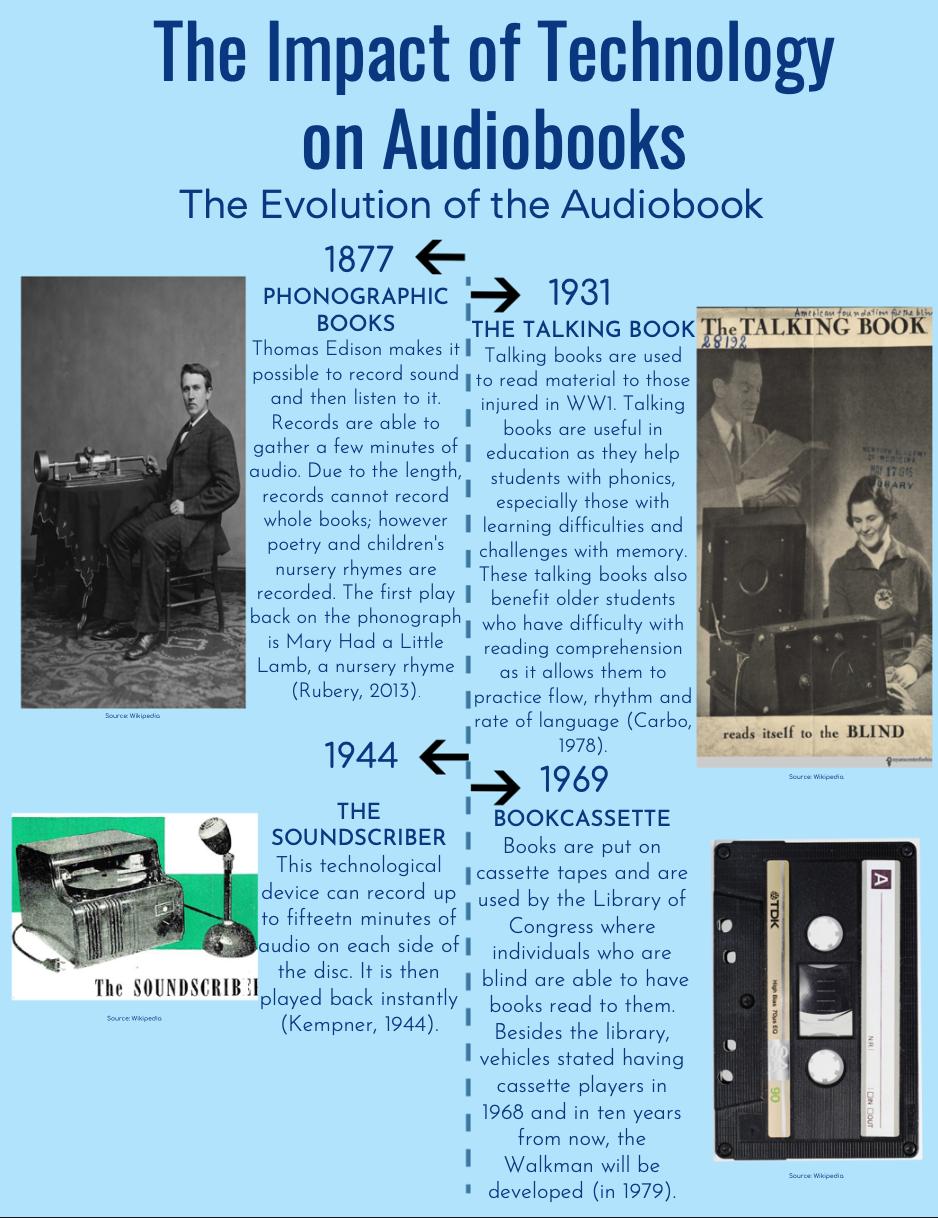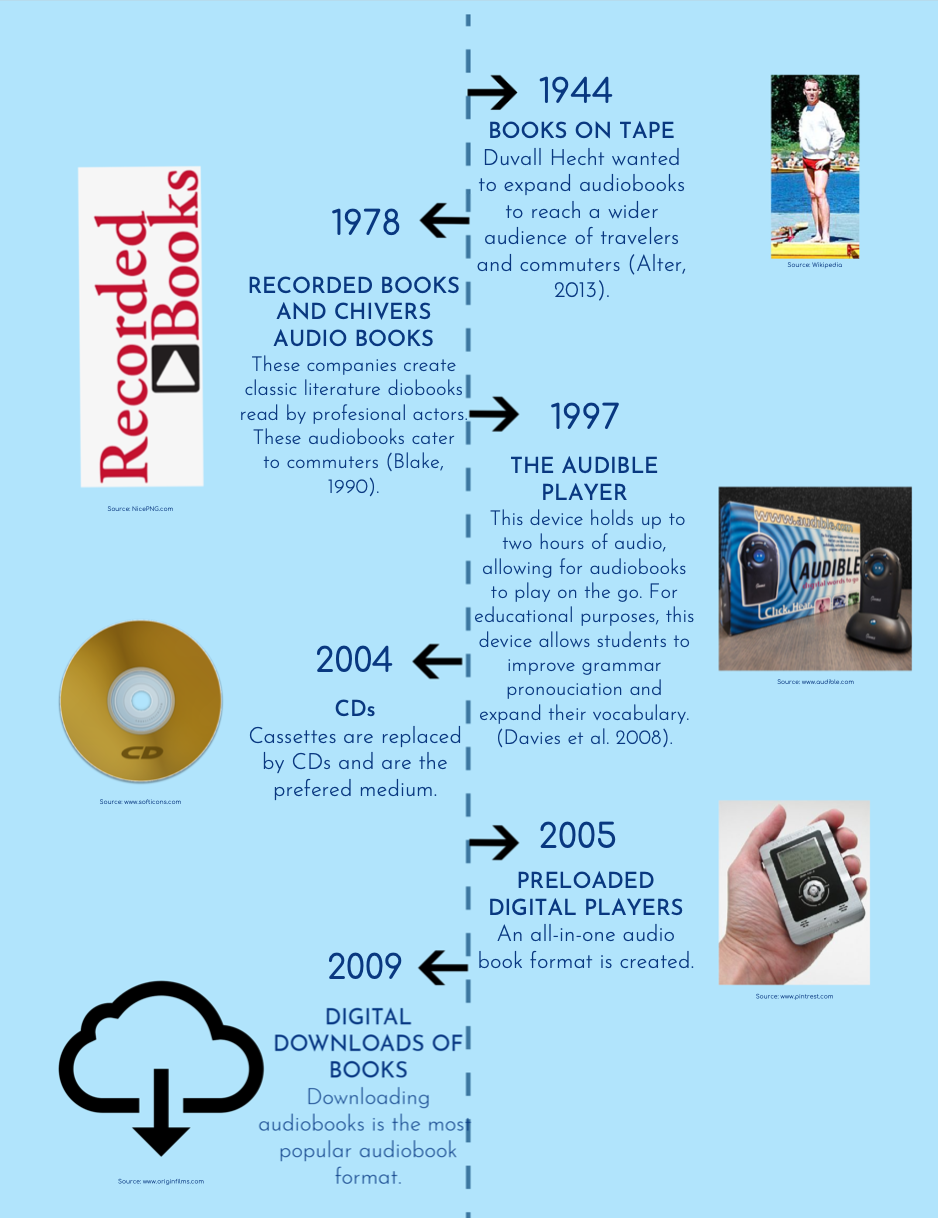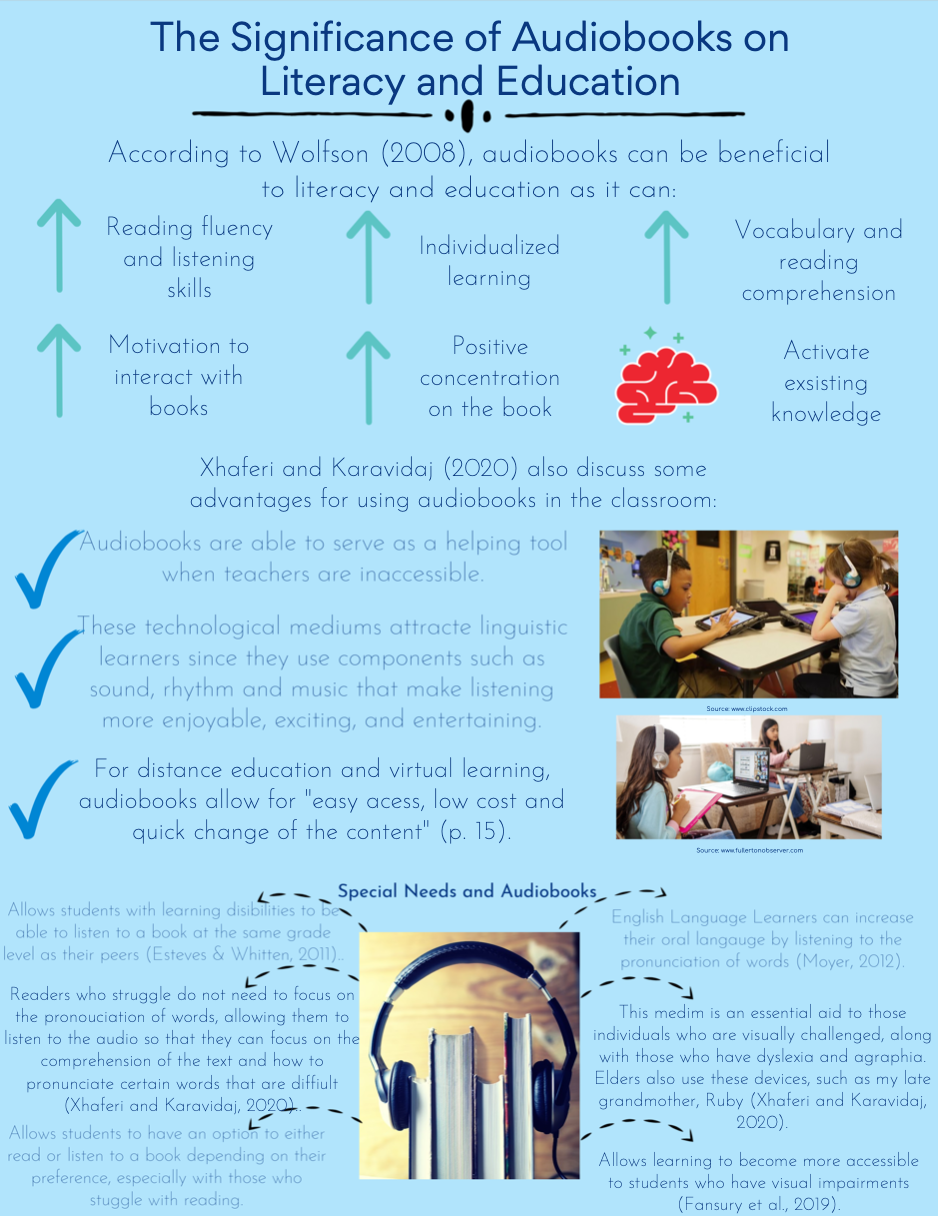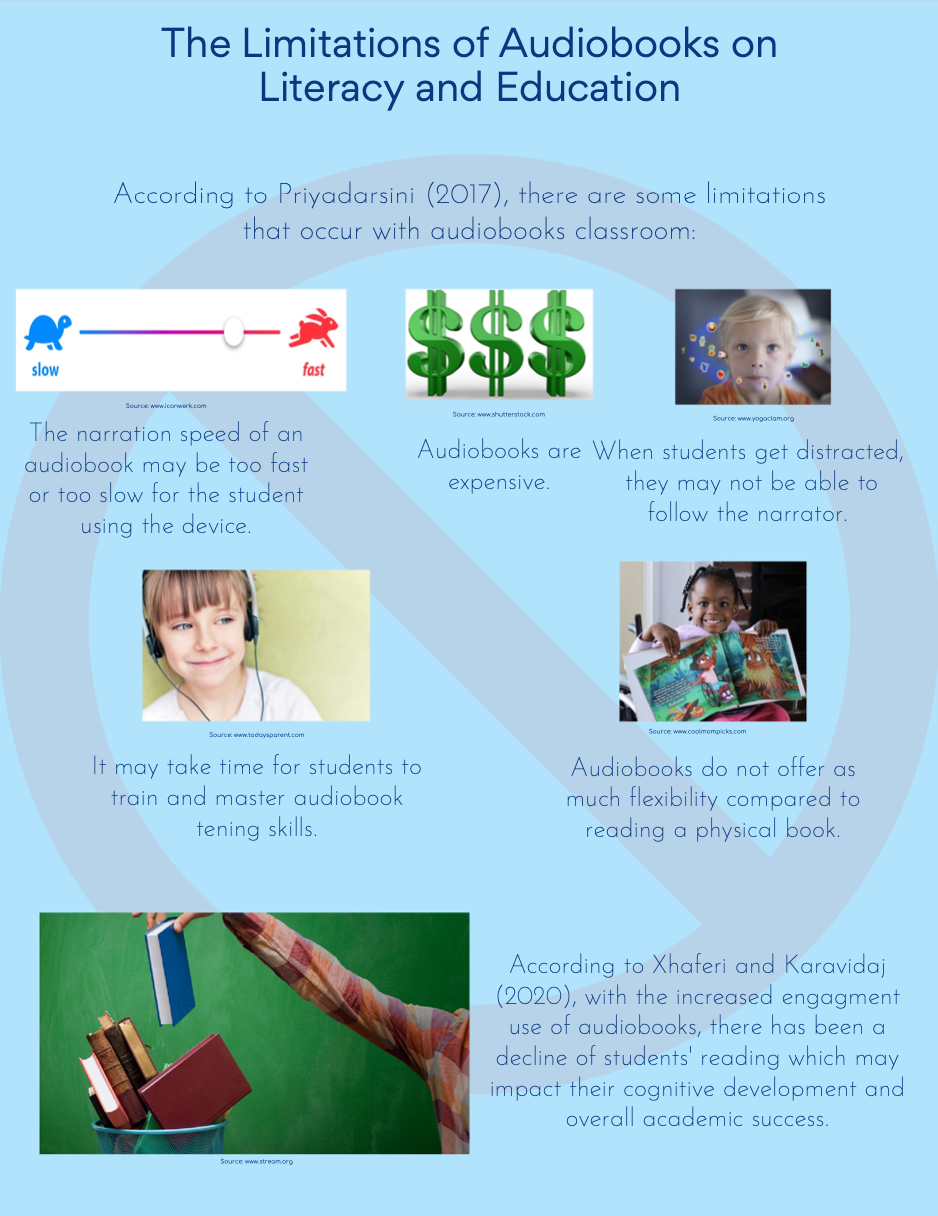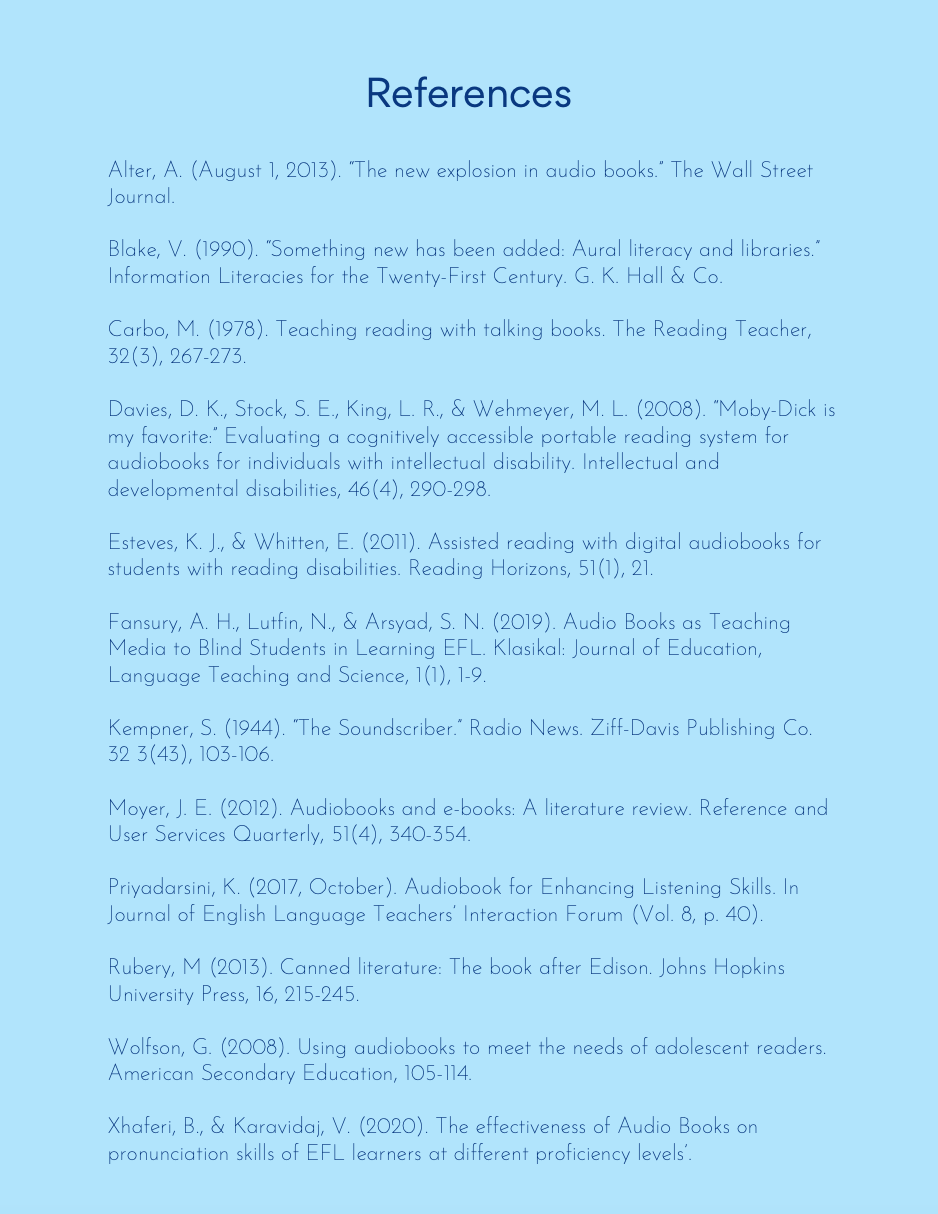Author Archives: Stephanie Carr
Linking Assignment #6
I decided to check out Kate’s Task 12 on Speculative Narratives.
During this task, we had to create two speculative narratives (utopian and dystopian). I struggled to come up with a good narrative for each. I was only thinking of using written output. However, I checked out tons of other people’s pages and I realize that I could have been more creative and have done so much more.
With Kates, I like how she did a simple pictograph that showed these two narratives in a visual mode. One is full of life and green, whereas the other one seems like robots have taken over humanity. I do wish that I could have explored these two worlds a bit more in depth as it felt like it was the cover of what was to be expected in these worlds. I would have liked to know more than just being provided with two sentences that tell readers what Technonia is. I thought I had to click somewhere to be let into this world! Anyway, I wonder how she created these posters. What platform did she use? Is it free? Easy to use? How did she come up with the name Technonia? I have so many questions but I know I will not get the answers to them as this is just a reflection. I wonder if there is a way to make this pictograph poster interactive where viewers could place the curser over a part of the image and up would pop content as to why something is how it is. That would be a neat feature.
I really do not have much more to say, so I guess I will go explore someone else’s Task 12 for another comparison.
I decided to then check out Tanya’s Task 12 on Speculative Narratives.
I haven’t even seen or heard anything yet but I can tell it will be engaging and interesting as I see a comic strip and a video. Yippie!
Tanya’s Utopian narrative is done in a visual and written linguistic mode. I really enjoyed viewing the narrative this way. I was able to look at pictures while reading what each character was talking about. Technology came into play through virtual learning with a hologram teacher, where the character in the story could stop, rewind, and pause when needed. This would be amazing and students would be able to learn at any time of the day that suited them or their parents. I even like how they were able to go onto a virtual field trip. I bet it would have been like the Magic School Bus where the student or students would be able to explore science up close and personal. I love this! This would be amazing if we, as teachers, could somehow do this in the future. Students would be able to understand, comprehend, and grasp knowledge in a way that would be beneficial to their learning and academic growth. I would have loved to see how this virtual field trip would have looked like so that I could imagine it even better than I am now. What a fabulous idea! Tanya used Pixton to create this narrative. This is a platform that I have not heard of but would like to try in the future or introduce to colleagues at work to use with the older grades.
With Tanya’s next narrative, she used Animaker. Again, this is a platform that I have not heard of and would like to try out as it looks like it would be tons of fun to create content in. Having a visual and auditory narrative mode allows the story to come to life as you are able to fully see what it would look like. This world is completely consumed with technology with every aspect, from when the character wakes up, gets food, commutes to school, the teacher is on the computer, the exercise instructor is even on a screen, playing games is all online, and this character seems to have no friends but virtual ones. This is a sad life filled with and overload of technology. Tanya portrayed a great dystopian narrative by using Animaker to make that come to life. It would have been great to see how this character’s friends looked like online. Are they actual computer characters? Are other people playing them? Or are his friends all around the world but only seen through the online world?
Tanya did a great job explaining these two narratives using different modes of linguistics. I am excited that I have now learned about two different platforms that look cool to use and test out!
Linking Assignment #5
I decided to explore Amy’s Task 10 on Attention Economy.
Oh yes, the Attention Economy Task. I feel like I have a love hate relationship with this User Inyerface.
Amy had the same problem that I encountered while trying to get past the first section on this, so called “game.” She had problems with not being able to have a password that was safe enough to continue on. My first question about this is, what browser was she using? I found that in order to progress in this “game,” I had to change browsers, and then I was able to move on from that password error. Did she try switching browsers? I don’t think so. I did not think of this until I came back to my school computer a few days later. At work, I was having trouble with playing audio or something along those lines, however when I switched browsers, it was able to work. So I just figured this was the problem with this game and I was correct. On my computer, Chrome was able to work, whereas Safari did not work. I wonder, too, if this has to do with any updates that are needed to support different sites. I like how in bold, she puts that she even tried using a Cyrillic character, which I tried too. However, I found that adding a Cyrillic character did not matter.
I wonder how Amy would have done if she was able to complete the first section. Would she be able to get through the game or would she encounter other problems?
Linking Assignment #4
I decided to explore Delian’s Task 7 on Mode Bending.
With both of our tasks, I feel like we both had an enjoyable time creating the content!
Delian’s approach was done in a way where she was pretending to be her little red bag. This was such a creative way to portray the content of her bag, the bags feelings, and the bag’s view of the contents that are placed inside this bag. I enjoyed this audio so much as I would not have thought of doing this task in this way. I have never thought about how my bag would feel or what they would say if they had a voice. If I had the time, I would have love to tried this with my bag or any item that I use on the regular. Delian’s mode was done in an audio linguistic way with a narrative, but there were also sound effects at the beginning and the end of the bag unzipping and then zipping up. This allowed me to feel as if the bag was right in front of me. I did like having the picture of the contents of the bag up on the screen so that I was able to visually imagine the what the bag looked like. With mine, I sang a song plus provided the visual. I wonder if I were to background sound effects, would that make my audio linguistic mode more elevated or would it be distracting?
I like how Delian used SoundCloud to record the audio for this task. This is a tool that I have not personally used but would like to use it in the future. When I did this task, I used an app called Voice Memos for recording my content, which was put into a song about the contents in my bag mixed with a typical day.
It was also neat to see how different two people are. Delian clearly loves to do trail running in Hong Kong and the contents in her bag definitely reflect that. Even though I do not know Delian, I feel like with this mode of display, I was able to learn about her through the voice of her red little bag, which is someone who knows her really well. I, on the other hand, am not a trail runner. I may like a hike here and there but you would not guess that from the contents in my bad. I seem studious and focused on my school work and have items that are needed to keep me going.
Task 12 – Speculative Futures
Utopian
Source: Pintrest
In the year 2050, everything is technology based. Cars that used to run by gas no longer exist and are used as decorative pieces in the city as there is no more oil left in the world. There is so much more greenery and society is more ecologically sound and everyone is seen as equal. Education is free. Health care is free. Living is free. Everyone works together and helps each other out. Death still occurs but humans have this enriched technological body that lasts so much longer. Once your body vessel expires, it will be put back into the earth, but you will then turn into a digital form of yourself where you are able to occur on this earth in a pixelated form like a hologram.
As for transportation, there will be underground roads where all vehicles are computer driven and can fly and go in the water when needed. All buildings will be generated by renewable sources such as the wind, sun, and geothermal.
All beings are either human or robots. Humans will get chips inserted into their wrist that will be used for everything. This chip will act as the key to your house, locks/unlocks everything that it is programmed to, can also be used for payment ( like a credit card), your driver’s licence, all of your medical history, and it will be able to start up your self-driving car. With this chip, everything will be controlled. Your blood pressure, heart rate, steps taken, body temperature, blood levels to see if all your levels are okay, as well as calorie intake and outtake. If there is anything occurring that is out of normal, there will be a hologram that will show up right in front of you with your levels. This chip will also be able to detect any diseases or onsets, like a heart attack, that may occur. You will be able to get help before anything bad happens.
With the educational program in this utopian world, students and robents (robot students) are able to have access to everything technology based, such as iPad, computers, VR goggles, 3D printers and pens. EVERYTHING is available. Each student also has an Artificial Intelligent (AI) robot that is by their side to help with any questions possible. These AIs guide and tutor each student to make sure that they are up to their academic potential. Also everything in the building is command based with facial, retinal, and voice recognition. Teachers are also paired with an AI who helps them out with all of the tasks that need to be done, such as photocopying, laminating, prepping for lessons, tidying up, sanitizing the room, and communicating with parents by constantly sending them updates on their child.
A typical day for a human would look like this.
I wake up.
Stephanie: “Alexa, turn on the light, open the blinds, and turn the home temperature to 18 degrees Celsius.”
Alexa: “Yes, Stephanie.”
I get up and say good morning to my robodog, Bot, and to my AI housekeeper, Sir Chip.
I use the bathroom, and wash my face. Sir Chip lays out all of my toiletries to make my morning routines go smoothly. I place my face in this device that washes my face and brushes my teeth.
In the bathroom.
Stephanie: “Alexa, start the water for my shower and set the temperature to 26 degrees Celsius.”
Alexa: “Okay.”
After I get out of the shower.
Stephanie: “Alexa, stop the water and self-clean the shower.”
As I walk to the bathroom to my bedroom.
Stephanie: “Sir Chip, may I have pancakes for breakfast with tea and orange juice please?”
Sir Chip: “Of course, Mistress Stephanie. Can I get you anything else?”
Stephanie: “No, thank you.”
Sir Chip: “Very well then.”
I get into my bedroom.
Stephanie: “Alexa, find my clothes.”
Alexa: “What would you like to wear today, Stephanie?”
Stephanie: “Something comfy yet professional, please.”
Alexa: “Coming right up, Stephanie”
After getting ready, I eat my breakfast made by Sir Chip.
Stephanie: “Bot, fetch me the ipaper.”
Bot: RUFF RUFF
Stephanie: “Alexa, can you put on my morning music?”
Alexa: “Yes, of course.”
It is now time to go to work.
Stephanie: “Alexa bring my car to the front.”
Alexa: “Yes, Stephanie.
I lock the door to my home with my chip in my wrist. Then I unlock my car and jump in. My car drives and flies me to work.
When I get to work (which is at a school because I am a teacher), my AI robot has a hot soy chai waiting for me on my desk, along with any updates from the principal or parents. The classroom is full of technology and every student has their own rolling cart filled with all of the toys you could imagine. Days go by great as all students have their own AI for the support that they need. We all work together to make sure that all the students are successful in every single way.
Dystopian

Source: Pintrest
In the year 2050, all humans still have chips in their hands that would monitor everything we do, however, robots would be in control and watching our every move. Buildings and structures are all around with no greenery in sight. There is also a dome that covers the city where you must remain inside or else you will start to crumble into a million pieces.
All humans and robo-humans have digital numbers on them. In order to get ahead in life, the digital numbers will act as points. The higher your number, the better a person you are. The lower the number, the crappier the human you are in the eyes of the society you live in. Every time you do a good deed, you will earn points. Whoever you did the good deed for would be the one who is able to control your points with that interaction.
If you do something rude or not nice to other humans or seen by other humans, they would take out their phone, scan you, and take points away. Everyone around you controls your points. This will also determine how well you do in life. It is not about the money but about the points you earn on how others view you. Once you go down to a certain number of points, you get into the red zone. Once you get down to 0, you will blow up into pieces and the cleaning robots will scrape your flesh and blood off of the floor and walls.
Sounds simple enough to get a good person and do good deeds, right? Wrong. Your whole life and your movements are monitored and controlled. There are curfews, strict rules, and robots that monitor the streets with point zappers and gun blasters towards you. No one goes to school. Everyone does what the robots in charge ask of you. If they want you to learn a trade, they will teach you. You do as they say.
A typical day for a human, would look like this:
Diary from Stephanie. Day 734.
The lights come on and the drapes draw back automatically. We are forced to get out of bed by the robots at 6:30 AM. Everyone who lives in the city under this dome must take part in cleaning up our city to make it immaculate. Once we are done with that, the government forces us to do jobs that we are not fans of but we have to have a positive outlook as these digital numbers on our chest determine our fate. I try to be the best person possible by being a kind and helpful individual. I do not know how long I can wear this mask for. I may show that I am happy but in reality, I am miserable. This is not the life I imagined for myself. Oh no, I have to stop thinking about this as my levels will be out of sorts and the robots will know that something is off. I must continue to keep a happy face on.
Throughout my day, I constantly praise others and help them in every possible way so that I can earn my points. If you get to 50 million points, we will be upgraded to another dome that is bigger and better. I know some people who have moved onto the next dome. I still have a long way to go. I have 15, 892, 347 points. I have such a long way to go but I am determined. My entire family, aside from a couple of second cousins, have been able to leave this dome for the better one. One day…one day…
As I was walking back from work today, before getting into the self-driving car, I bumped into a lady by accident which spilled her coffee all over herself. She came out of nowhere. I tried to help clean her up but she wanted nothing to do with me. She knocked me down 23 points. How is that fair??? I didn’t even see her coming!!! I was so angry that other people saw me break down and they started to knock more points off of me. There were 6 people around and the more angry I got, the more points they took from me. By the end of this encounter, I had lost 148 points. What the heck!!
Oh no I better not get worked up again. The robots will come and I will get in so much trouble as I have to always be happy and positive. How am I going to make it to the next dome?? I better just forget about this day and go to sleep.
Task 10 – Attention Economy
Well that was annoying and frustrating.
First of all, what was that? I tried this “game” three times and then gave up. However, I do not like to give up.
There were many challenges that I encountered.
1) Scrolling to the bottom of the Terms & Conditions.
- I started to get Carpal Tunnel in my wrist. Then I googled how to quickly get to the bottom of a page. So I used alt and swiped down. Okay great. I was able to accept.
2) Figuring out a password
- Well that was fun. I was able to do all of the requirements for the password but then I needed a Cyrillic character. Yes I had to google what that was. I also figured out that it had to be 9 characters, one capital letter, one numerical, at least one letter from my email, and one Cyrillic character. (later on, I realized that it did not matter as long as your password contains one uppercase letter and one number.)
3) The box that comes up from the bottom of the screen.
- At first it was annoying because I could not get it to go away. Then I pressed, “send to bottom” and it was all good. After that I just ignored it.
4) The “Hurry up, time is ticking!” box appeared.
- Lock?? Unlock?? It was just messing with me. Then I read down at the bottom left that it said ©lose 2021. Very clever. It is annoying that it pops up every minute though.
Have I been able to go past the first section…nope. I will keep at it.
I needed to google User Inyerface to see if I could gather any clues as to how to do it. So weird. I have done everything that it told me to do and I cannot move to the next section. I wonder what it is that is making it so I cannot move on. I really want to move forward in this game!!!
Many days later….
I gave myself a few days away from this game and decided to open it up in another browser. Yes that was the problem. I could not get past the first part as, I suppose, the game did not like that I was in Safari. Once I tried it in Chrome, I was able to get a time of 5:03 by going all the way to the end.
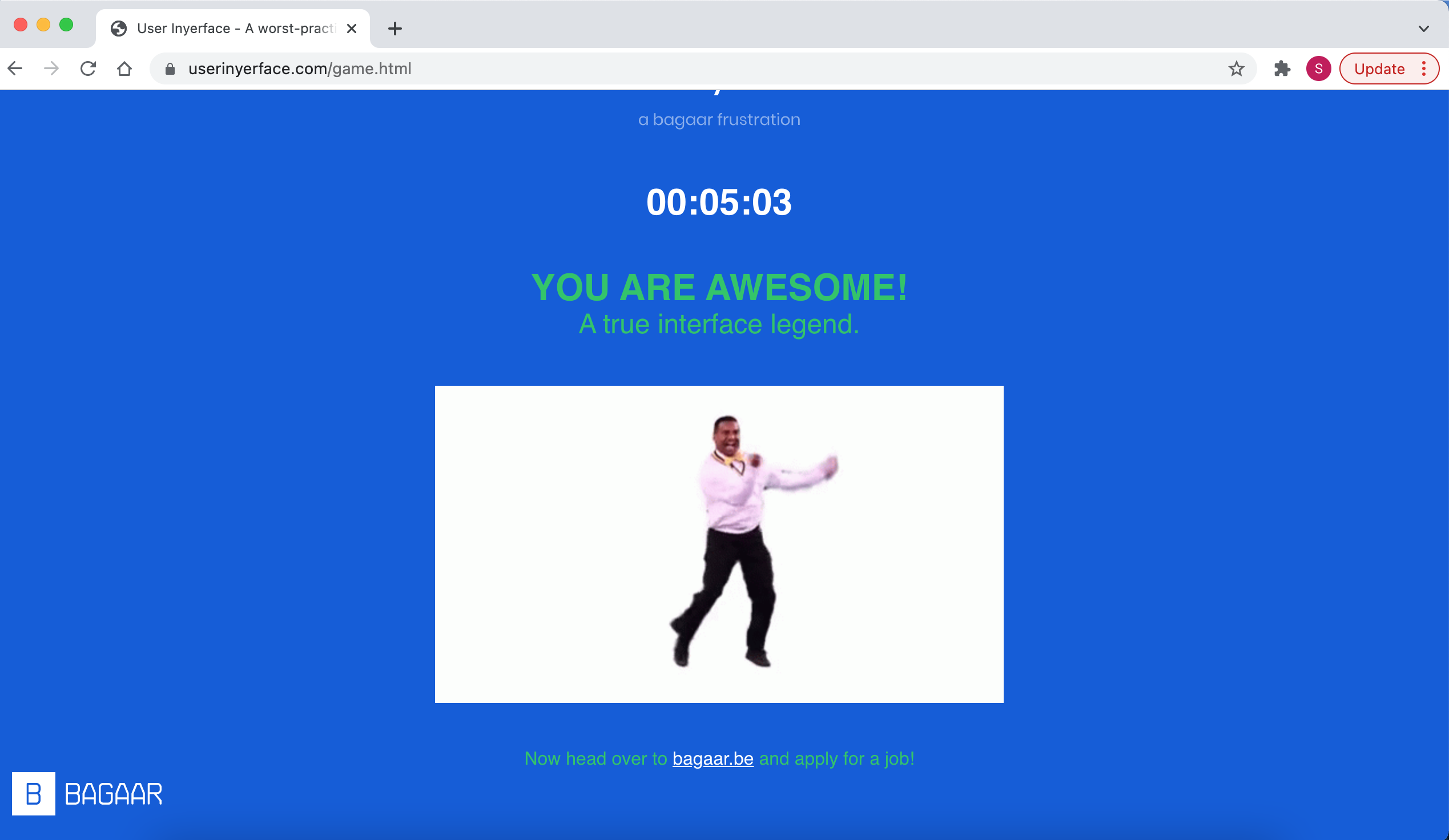
Now that I know how this game works. I am going to try it again as I am competitive and want a much better end time. By trying it again, and knowing how everything works, I was able to get a time of 1:24. Not bad. I think that is good enough for me.
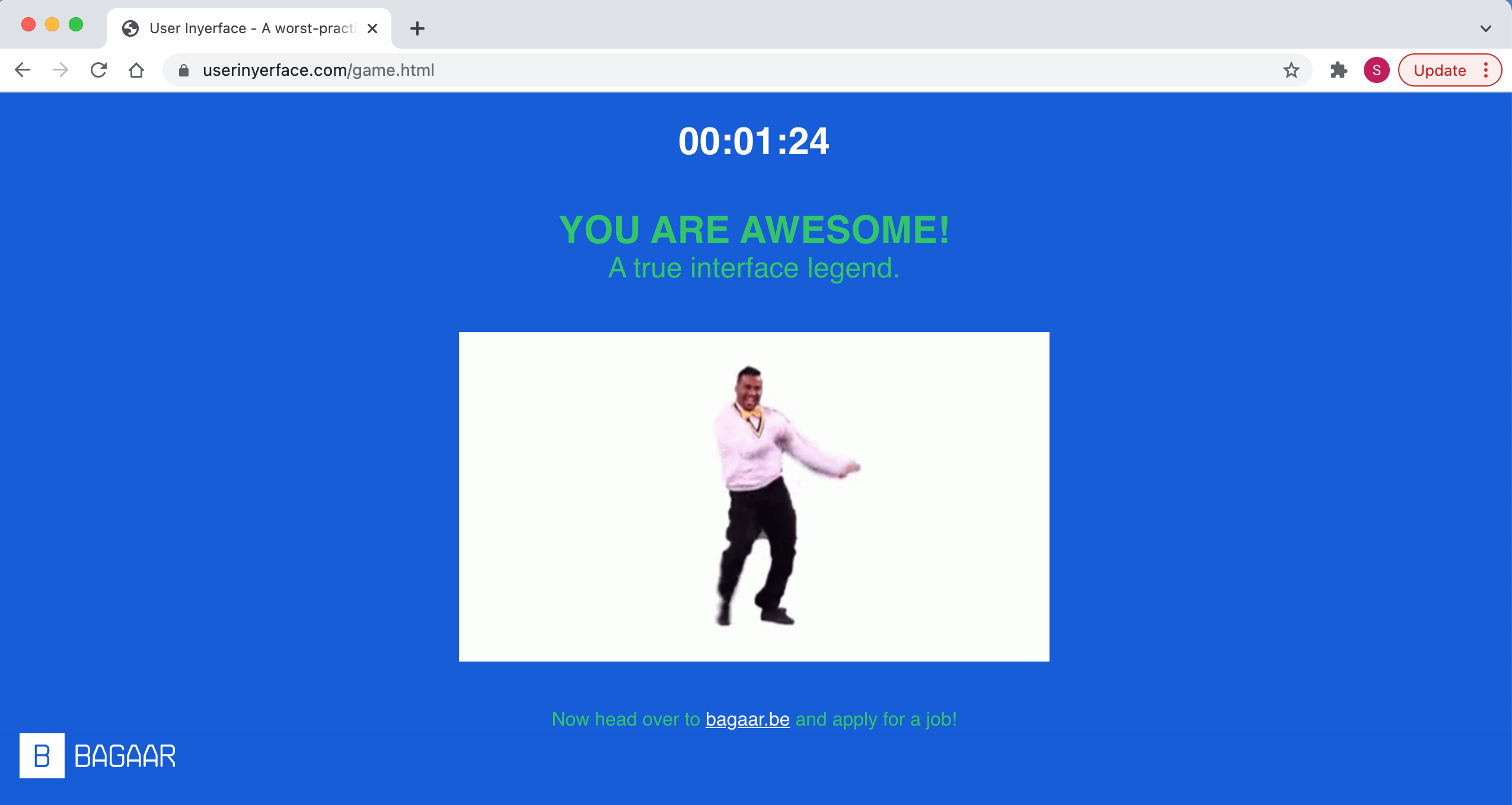
To me, this type of User Inyerface game, or should I say an initial irritation, consisted of a “dark pattern” (Greenberg et al., 2014, p. 524). A dark pattern is “a type of user interface that appears to have been carefully crafted to trick users into doing things [that] are carefully crafted with a solid understanding of human psychology, and they do not have the user’s interests in mind” (Greenberg et al. 2014, p. 524). User Inyerface successfully achieved this. The types of dark patterns that occured on the User Inyerface were trick questions, misdirection, bait and switch. According to Bringnull (2010), trick questions occur when an individual is “filling in a form [where] you respond to a question that tricks you into giving an answer you didn’t intend [, however] “[w]hen glanced upon quickly the question appears to ask one thing, but when read carefully it asks another thing entirely” (para. 1). Misdirection is when the “design purposefully focuses your attention on one thing in order to distract your attention from another ” (Bringnull, 2010, para. 6). Finally, according to Bringnull (2010), bait and switch is when an individual “set[s] out to do one thing, but a different, undesirable thing happens instead” (para. 6). Technology developers are able to think about and understand human psychology in a simple way that can easily be flipped over into the dark side (Bringnull, 2011).
In Harris’ (2017) TED talk, he mentions how social media, websites, and entertainment streaming companies, such as YouTube, Netflix, Facebook, and Snapchat, are racing for our attention as they control user’s behaviour intentionally. For example, Harris (2017) mentions that with Snapchat there are millions of teens that use this app every day and there is a Snap Streak that teens are addicted to where two people communicate with each other every day. Snapchat created this intentionally as it “gave two people something they don’t want to lose” as they want to maintain their streak so it does not disappear (Harris, 2017, 3:25). Ultimately, understanding and controlling human psychology allows for these technological companies to be successful as everyone that owns any piece of technology is affected and stimulated by these dark patterns and susceptible to the attention economy.
References
Bringnull, H. (2010). Dark Pattern. https://www.darkpatterns.org/types-of-dark-pattern
Brignull, H. (2011). Dark Patterns: Deception vs. Honesty in UI Design. Interaction Design, Usability, 338.
Greenberg, S., Boring, S., Vermeulen, J., & Dostal, J. (2014). Dark patterns in proxemic interactions: A critical perspective. Paper presented at the 523-532. https://doi.org/10.1145/2598510.2598541
Harris, T. (2017). How a handful of tech companies control billions of minds every day. Retrieved from https://www.ted.com/talks/tristan_harris_the_manipulative_tricks_tech_companies_use_to_capture_your_attention?language=en
Task 9 – Network Assignment Using Golden Record Curation Quiz Data
During this task, we had to observe our Golden Record network that was created in Palladio where it showed the musical choices from the quiz that students in ETEC 540 took last week. In our class there are 22 students that chose 10 out of 27 tracks. The image below shows the network of connections between students and tracks. I moved around the network so that the tracks were on the outside and the students were in the middle.
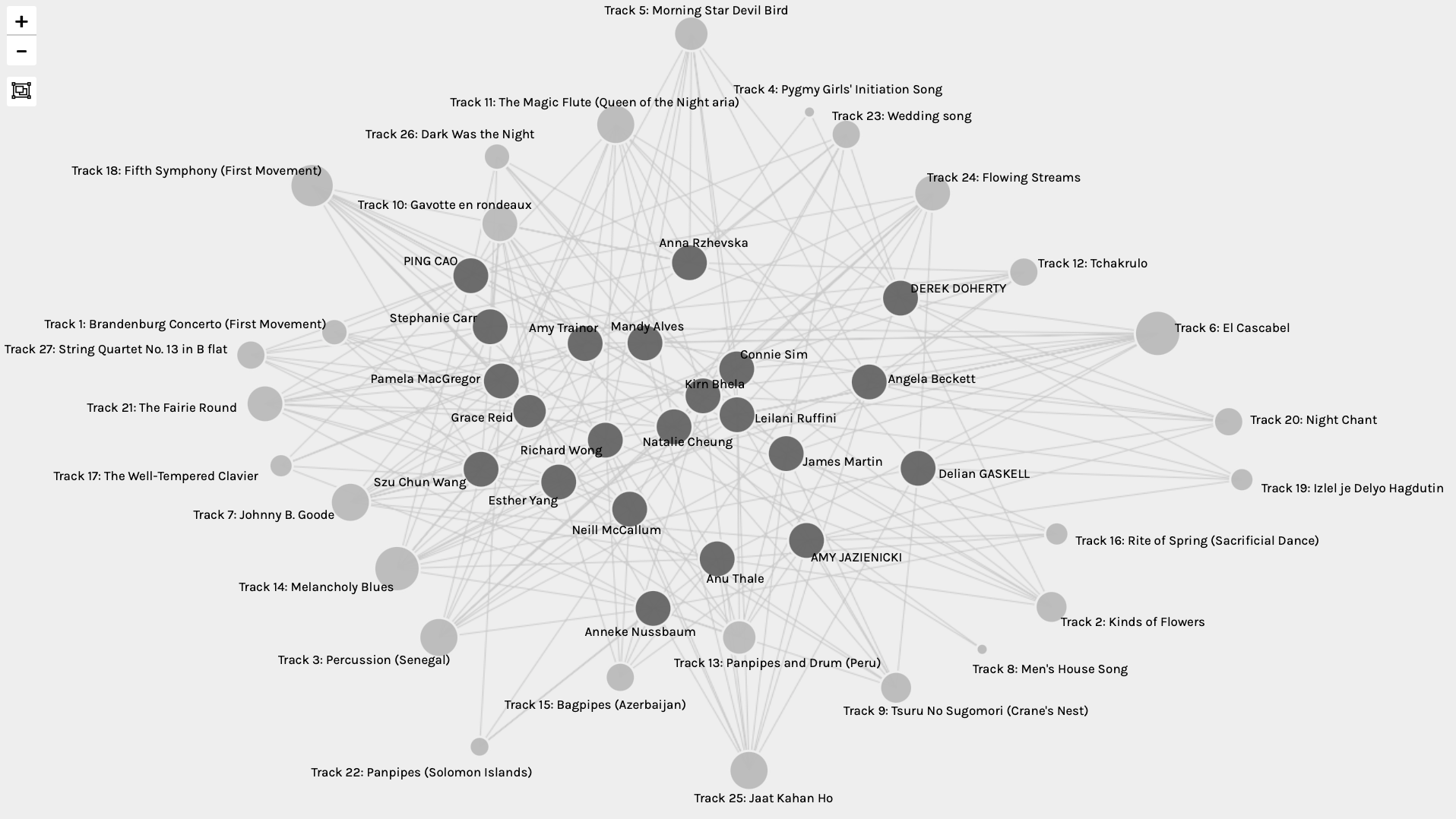
In this network graph, there are nodes and edges. The nodes represent the students which have dark grey circles and the edges in this network graph represent the connection between a student and the 10 tracks they chose during the quiz. Not only are the lines connecting a student to the 10 tracks that they chose, but with each track, there are connections that link together with all those chose that track. Surprisingly there were no tracks that did not have a connection. Track 4 (Pygmy Girls’ Initiation Song) and Track 8 (Men’s Housing Song) only have two degrees of connectivity that connect to the two individuals that chose that music. Whereas Track 6 (El Cascabel) and Track 18 (Fifth Symphony: First Movement) have the most connections and degree of connectivity with being linked to twelve students. I analyzed this by selecting the largest circle and then by counting the lines that I visually observed.
Next, I decided to explore and analyze Community 1 with the number of nodes. To me, it is unclear how these communities are made, but I assume it is because we had the most similar choices among the 10 tracks that we all picked. Myself and five others are in this community (Anna Rzhevska, Derek Doherty, Connie Sim, Richard Wong, and Mandy Alves). In this community, there were four tracks that only had 1 degree of connectivity. Those tracks were Track 15: Bagpipes (Azerbaijan), Track 19: Izlel je Delyo Hagdutin, Track 22: Panpipes (Solomon Islands), and Track 24: Flowing Streams. There were no tracks that had all of these students connected, however there were five tracks that had 5 degrees of connectivity. Those tracks were Track 5: Morning Star Devil Bird, Track 6: El Cascabel, Track 7: Johnny B. Goode, Track 12 Tchakrulo, and Track 18 (Fifth Symphony: First Movement).
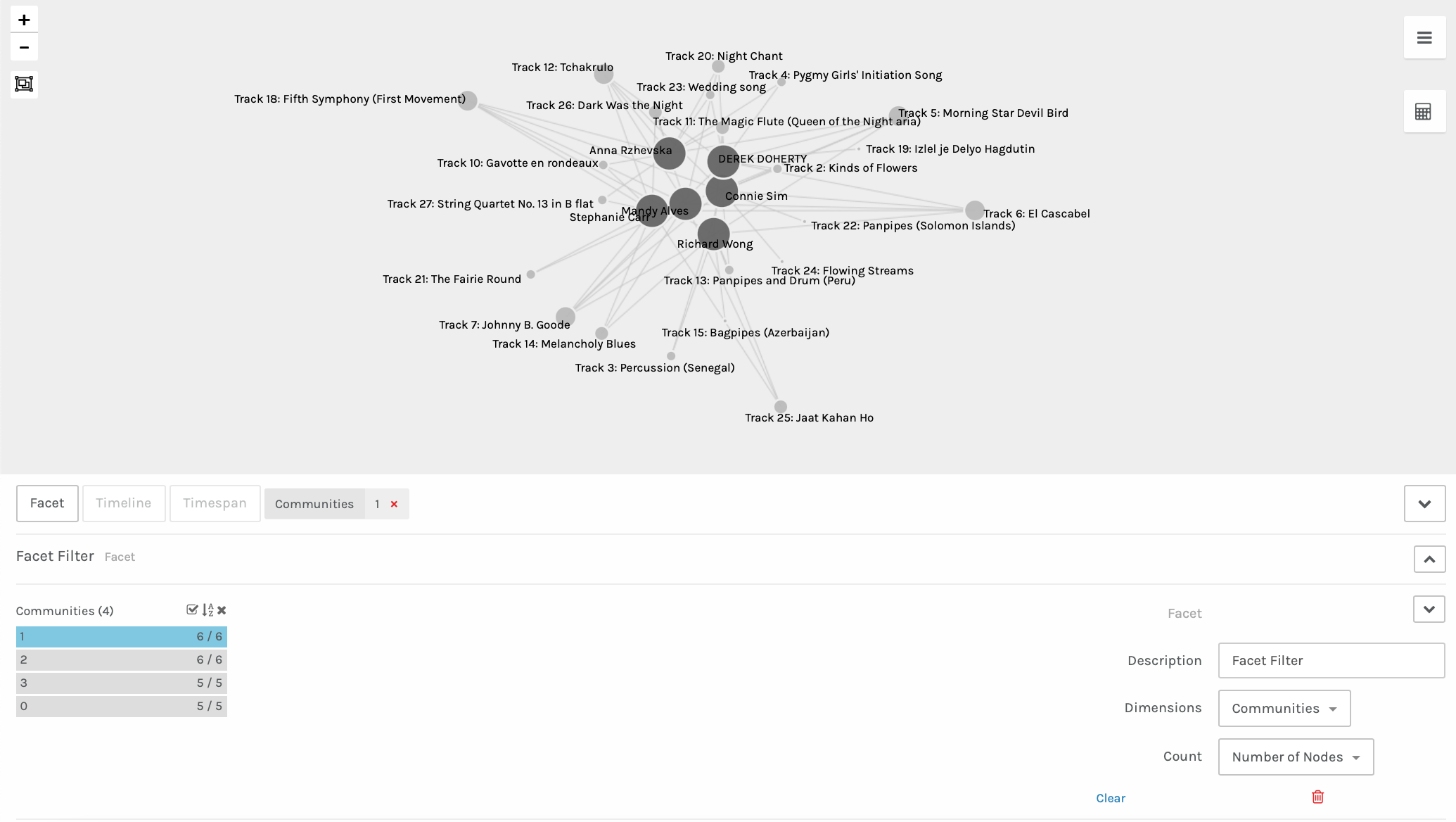
It would be interesting to investigate this data further by figuring out why each student chose the tracks that they did. The graph does visualize the connections between tracks but there is no data on why each person selected these tracks. As well, it would have been effective to also have data where the tracks could also be connected to the instruments that occur in each song. With this data, we could see if there were any correlations between the types of instruments and all the tracks that each student picked for their top ten tracks. I wonder how many more connections there would have been between all students. Also, it would be so neat and visually appeasing if the tracks were categorized into colours depending on either the instruments used (for example, all wind instruments would be blue) or the pitch and tones of the instruments (for example, very high pitched sounds would have a red colour, whereas low pitches would be blue). There are so many different ways that data could have been collected in order for us to see all the different connections between one another. However, I enjoyed this task as we were able to get a taste of what data networking looks like with the only data being the ten tracks each student picked.
I then wanted to see which student I had the most connectivity with, so I analyzed myself with the five other students in pairs. I discovered that myself, Stephanie Carr, and Mandy Alves connected the most.
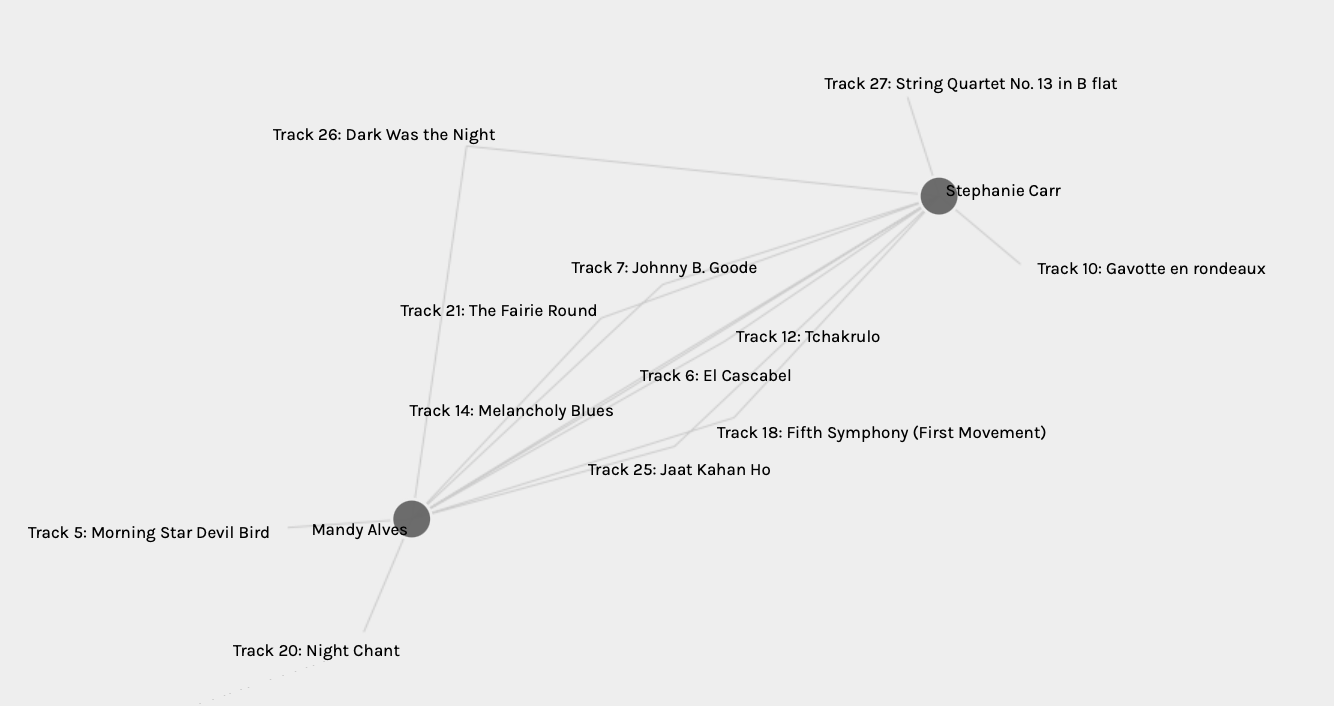
We both chose the same eight tracks out of the ten tracks we were allowed to choose. Do we both like the same types of music? Do we enjoy certain tones and instrumentals while listening to music? It would be fascinating to see why we both picked the eight tracks that we did. However, this data does not provide this information. I know this is not based on music, but I wonder if we were to both open up our Netflix to see what movie recommendations there would be, would it be similar? Does the type of music that you enjoy also correlate with the types of movies one enjoys? That would be neat to collect data on to see the similarities and differences.
When I think about the political implications, I think back to why I consider a committee from Cornell University were the chosen ones to determine which tracks would be placed on the Golden Record. Did they have biases on the tracks they decided to choose? Out of all the music in the world, how did they narrow it down to just 27 tracks? Also, how come not all musical genres were represented on this track? There are significant information gaps on the Golden Record and with the tracks that were selected for this voyage.
Now with reflecting on the political implications of the current data taken for this task, there are some missing gaps. With the visualizations of the data, viewers can identify which tracks were most liked and which were not. However, we can only see who the curators are and what tracks they chose instead of why they picked the tracks that they did. Were the tracks chosen only on the sound of the music? Or by the instruments played on the track? Or did individuals prefer instrumental music opposed to hearing someone sing? Or perhaps the curators just randomly picked ten tracks because it was too hard to choose? Or perhaps they did not have a liking to any of the tracks but had to pick ten for the purpose of these tasks? Without any reasoning or criteria behind why these tracks were chosen, the data really does not provide us with that much information.
Task 8 – Golden Record Curation Assignment
While listening to the Voyager’s Golden Record, I chose 10 out of 27 pieces of music. This was a difficult task as there were many more songs I would have included. I decided on these pieces as if I were an alien or a foreigner listening to the music for the first time. Some pieces that I omitted were too high-pitched for my liking making it hard to listen to the whole track, however, the following ten are pieces that I would see an alien swaying to. According to Rumsey in her online discussion, she mentions that we, as humans, need to reflect on the past in order to figure out what is needed for the future (Browns University, 2017). Therefore, hearing these pieces could allow an alien to recreate the music as there were not many complex instrumental sounds in these tec pieces of music.
I am not an instrumental specialist at all, however, these are pieces of music that my own ear appreciated. The 10 songs that I chose also reminded me of certain events and places that I have travelled to in my life, or just simply I enjoyed the sounds and tunes of the song.
Here are my top 10 picks.
- Peru, wedding song, recorded by John Cohen. 0:38
- “Melancholy Blues,” performed by Louis Armstrong and his Hot Seven. 3:05
- “Johnny B. Goode,” written and performed by Chuck Berry. 2:38
- India, raga, “Jaat Kahan Ho,” sung by Surshri Kesar Bai Kerkar. 3:30
- Holborne, Paueans, Galliards, Almains and Other Short Aeirs, “The Fairie Round,” performed by David Munrow and the Early Music Consort of London. 1:17
- Mexico, “El Cascabel,” performed by Lorenzo Barcelata and the Mariachi México. 3:14
- Bach, “Gavotte en rondeaux” from the Partita No. 3 in E major for Violin, performed by Arthur Grumiaux. 2:55
- Bach, Brandenburg Concerto No. 2 in F. First Movement, Munich Bach Orchestra, Karl Richter, conductor. 4:40
- Tchenhoukoumen, Senegal, percussion, recorded by Charles Duvelle. 2:08
- Beethoven, Fifth Symphony, First Movement, the Philharmonia Orchestra, Otto Klemperer, conductor. 7:20
| Peru, wedding song | This song is done in vocals with a female voice with no instruments. The sound of her voice is so beautiful that I feel like instrumentals would take away from sound. The sound of the female’s voice sounds young and intriguing that I wish I knew what was being said. This song would let aliens know that music can be done acapella and that all they need is their voice to create a sound that is pleasing. |
| Melancholy Blues | I thought it would be nice to add some jazz for the aliens to hear. This piece of music has brass instruments. Do I hear a trombone and a trumpet? This track reminds me of being down in the South listening to Jazz music on the streets of New Orleans, Louisiana. Now I feel like some crawfish, turtle soup, jambalaya and some Creole chicken. |
| Johnny B. Goode | This song just makes me want to get up and dance. I feel like it would also have the same effect on any life out in space. There is such a positive and upbeat sound to this tune that your feet would simply just tap if you did not get up and dance. It also makes you feel like you are playing air instruments and having your very own solo. |
| Jaat Kahan Ho | I liked the sound of this song as it would be great for another language to be put on this track. I feel like life in outer space knows the languages of those who have travelled from Earth. Therefore, having another language could be interesting for them to listen to. As well, they would realize that there are more languages than they may be aware of. |
| The Fairie Round | This track just makes me feel happy and makes me smile. I think it is because it reminds me of a German Christmas Market drinking mulled wine and buying knickknacks for those I believe will appreciate the kind gesture. |
| El Cascabel | In this song, it features a male voice, has an upbeat tune, and contains a guitar. It makes me think of eating at a Mexican restaurant or actually being in Mexico City listening to live music. The lights would be dimmed and I would have red wine in hand while tapping my feet along to the music. |
| Gavotte en rondeaux | The violin on this track sounds so beautiful that it is a must to be added. I can just picture two aliens closing their eyes and just moving their head to the sound and listening to each stoke of the strings of the violin. This song is very famous, which means that many countries are aware of this tune, so why not bring it to space so that the aliens can hear a famous song. |
| Bach, Brandenburg | This song is music that is light, easy to listen to, and can be playing in the background while doing just about anything for a nice ambience. I hear a flute and a violin. This reminds me of when my mom would take me to ballets and musical performances at the Queen Elizabeth Theatre. |
| Tchenhoukoumen, Senegal | This piece of upbeat music has many percussion instruments that makes it stand out compared to other songs that I omitted. I also like how there are layers of sounds which can display to the aliens that more than one sound can be put together to create a pleasing track. To me, this piece has positive vibes which could suggest that those on earth can, and possibly are, humans who have positivity within them. |
| Beethoven, Fifth Symphony | This piece of music is a classical song that only consists of instruments that are string and does not include any vocals. To me, this song is full of suspense which would show the aliens that music can sound different and allow listeners to feel different emotions. This song was created from 1804-1808, yet it is still a popular song today. Therefore, depending when the aliens receive this record, this song will still be a tune that will continue to be liked on different planets in hundreds of years to come. |
References
Brown University. (2017). Abby Smith Rumsey: “Digital Memory: What Can We Afford to Lose?”. Accessed via YouTube at https://www.youtube.com/watch?time_continue=4&v=FBrahqg9ZMc&feature=emb_logo
Task 7 – Mode Bending
For this task, I decided to create a song with original lyrics. It is about the items that I use in my bag and what happens for me during a regular work day. The lyrics are sung to the tune of Maroon 5’s “Memory.” Please keep in mind that I am not a singer, so this is as good as it will get! As a refresher, this is the image that I took of the contents of my bag from Week 1.
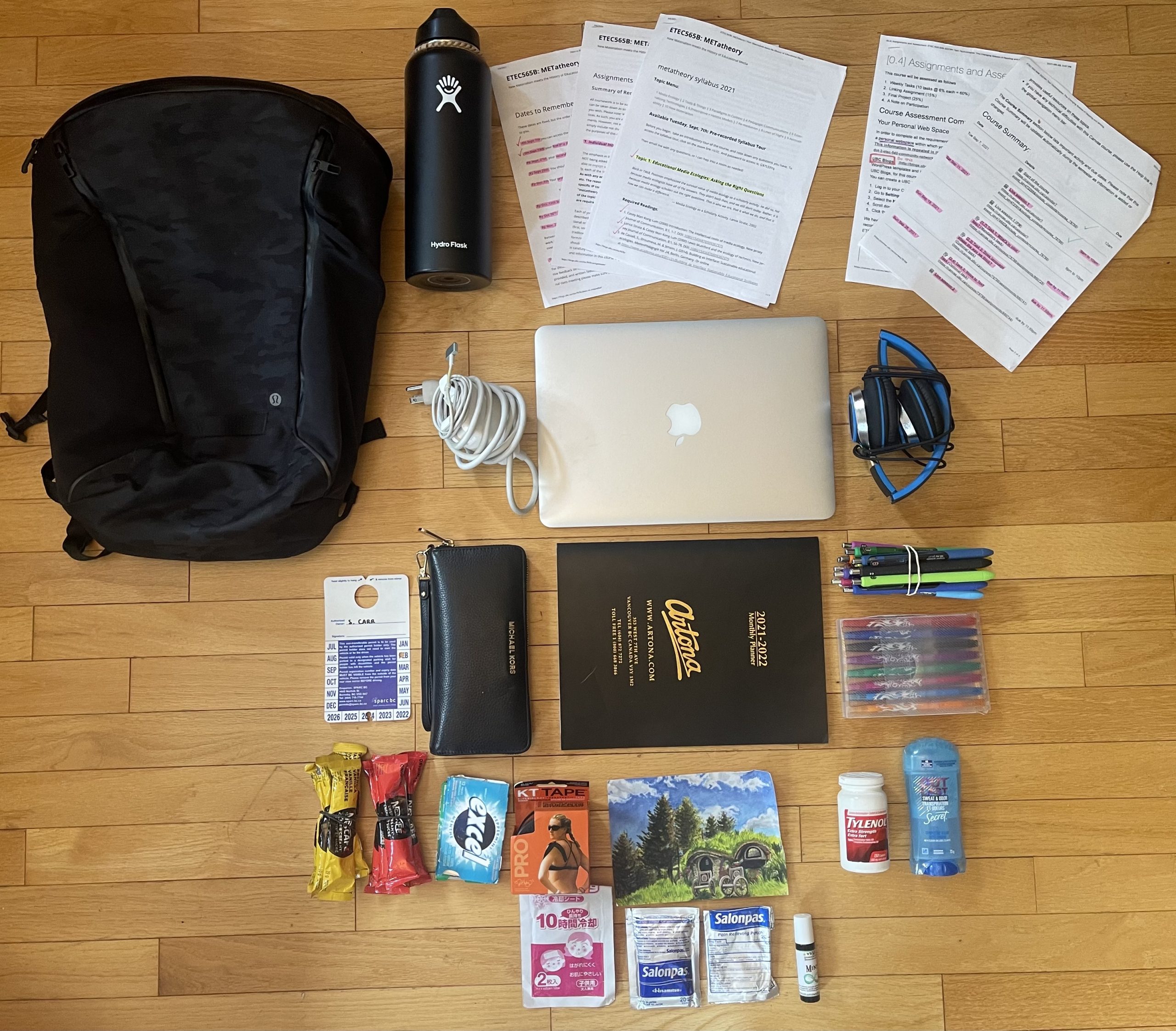
Click below, follow along with the lyrics, and enjoy!
Lyrics
I, wake up tired – every morning
I rush to get clothes and my lunch together
And then I make sure to check Google maps to see if my commute will be good
Then I walk my dog, Baby O
And make sure he goes pee and poo
And then he’s fed and medicated, as he has high anxiety.
I then put on my mask
As we are still in this pandemic
Make sure I have my work card, keys, and whistle around my neck
I make it to work just in time,
To open the window shutters,
And get out the hand sanitizer,
Okay here we go.
Deep breath.
I got this.
Good morning class,
Let’s try to have a good day.
Kindies come in all wild,
It’s going to be a long day
And an active one at that
Loudness and chaos is the description of my class.
Even though they are an active bunch,
all 18 of them tend to pull on my heart strings
By the end of the day, I am ready for a nap.
Doo-doo, doo-doo-doo-doo
Doo-doo-doo-doo, doo-doo-doo-doo
Doo-doo-doo-doo, doo-doo-doo
I am still ready for a nap.
I need to prep for tomorrow
And then commute home
In traffic
From Delta to Vancouver
Driving home is my down time
I then reflect on my day
Listen to music
And I’m on my way, oooo
Once I am at home,
It is time to pull out my computer
To start reading, doing assignments, and tasks for my masters
For a break,
I have my dinner to boost up my energy
As I need to get my homework done
Before the deadline.
Back to the computer I go,
I pull out my agenda and the two syllabuses,
So I can check off what I’ve completed and cross out what I’ve read.
Doo-doo, doo-doo-doo-doo
Doo-doo-doo-doo, doo-doo-doo-doo
Doo-doo-doo-doo
I am almost a master
Doo-doo, doo-doo-doo-doo
Doo-doo-doo-doo, doo-doo-doo-doo
Doo-doo-doo-doo
Soon I will be done
We are half way through
This semester,
I cannot wait to be done.
Only 6 more weeks to go.
The evening comes around so fast,
Now I get to lay in bed
With Oslo
And watch some TV like FBI, NCIS, 911, and Greys.
Now it’s time to take my pills,
I take 12.
It’s a shit ton
But I need it
In order to physically
Make it through life.
It sucks but I have to,
So I do it.
Alarms are set,
All 5 of them are ready.
7:00, 7:15,
7:30, 7:45, and 8:00.
I lay in bed for hours
Because my mind and body can’t settle.
I TikTok it up until my eyes are blurry
And my phone drops on my face.
Now past 1am
And I wish I could have slept early
But I didn’t so I watched hours of nonsense
And learned new things from randoms around the planet.
Doo-doo, doo-doo-doo-doo
Doo-doo-doo-doo, doo-doo-doo-doo
Goodnight world.
This was such a fun assignment. I really hope I did it correctly and was able to weave the contents of my bag into what a day in my life looks like. I brought the contents in my bag to life through this parody. I was able to find an instrumental cover of the song “Memories” by Maroon 5 on YouTube so that I would have the correct tune to one of the songs I enjoy the most right now. This allowed me to use the tune to help formulate the rhythm of the lyrics.
In week one when I described the contents of my bag, I did it in a way that could be viewed visually and textually. Now, as we have moved onto week seven, this task is viewable in another multiliteracy mode where it can be accessed in an audio form. The New London Group (1996) states that “new communications media are reshaping the way we use language” and that “there cannot be one set of standards or skills that constitute the ends of literacy learning” (p. 64). As the world is full of diverse individuals that have differences throughout every aspect of communication, it is important to make literacy available in an array of multimodals. As well, The New London Group (1996) states that “dealing with linguistic differences and cultural difference has now become central to the pragmatics of our working, civic, and private lives,” which suggests that items need to be produced in multiple ways that are available cross-culturally (p. 64). As an educator, we have to make sure we are able to reach all of our students by using multimodal ways to teach them and understand the different ways that our students learn, whether visually, textually, orally, or spatially.
After I completed this task, I sent the audio file to my sister and my niece and nephew watched it, as well. After they watched it, my nephew, who is in kindergarten, was inspired to share a day in his life from his point of view. I decided to add it to this post. He was able to recreate this task from his point of view in a visual and audio mode. This is how he is best able to describe his day since he is unable to do it textually. I am only sharing the audio portion due to privacy. Click below to listen.
References
The New London Group. (1996). A pedagogy of multiliteracies: Designing social futures. Harvard Educational Review 66(1), 60-92.
Linking Assignment #3
The next post I am going to link to is Jacob’s emoji story.
Firstly, I am going to share the comment I posted on his blog site:
“At first, I was like what is the title?!….Then I said it out loud. I see what you did there. Very clever. It is almost like that game where you say the words on the card that look like gibberish, but then when someone hears it, it sounds like something you know. I then glanced and skimmed the emojis and saw the hand gesture and alien heads which confirmed the tv show. I only saw it when I was younger and my older brother would watch it so I don’t know the storyline or plot, but I was able to guess it right away just from the title and some hints.”
Jacob and I both did TV shows, however he did Star Trek and I did Squid Game. First of all, we both used different emoji pictures. I used the ones from Apple on my iPhone. Jacob, on the other hand, used a different program. Using a different emoji program made it more difficult for me to understand the story because I had to really look at the emoji to determine what it was. For example, some of the facial expressions were hard to figure out as the eyebrows and hands were not as prominent as the ones from Apple.
What I do wonder is how Jacob decided on these images. Did he type in a word to find the emoji that he wanted? Or did he just scroll through all of the emojis and pick one that seemed to sum up what he was trying to explain?
I also believe that Jacob summed up the entire storyline of Star Trek which, to me, is a very difficult task to do as you have to make sure that all the details and information are correct. Did Jacob recall all the events that happened from start to finish? Or did he look up the episode summaries to refresh his memory? I know that when I wrote out the emoji story for Squid Game, I decided to just do episode one since I felt like this emoji story would be much too long and complex. After I completed the emojis for episode one, I then wanted to make sure that I was not forgetting anything, so I googled the episode summary and it allowed me to add an event that I missed. I wonder if Jacob did the same thing.
Jacob mentions that the “usage of these emojis does not necessarily follow any standardized set of meanings, how someone approaches these visuals can seriously diverge their understanding from my intent” (para. 3). This is very true and something I had not considered. I feel like if a person who has seen this TV show understands which show it is, they will be able to figure out what the emojis are trying to explain. I also believe that even if two people were to do the same show in this emoji form, they would have completely different outcomes. Even though the plot is the same, it may have derived a different meaning.
References
Jacob (2021, October 17). Task 6 – Emoji Story. https://blogs.ubc.ca/gleckmanetec540/2021/10/17/task-6-emoji-story/
